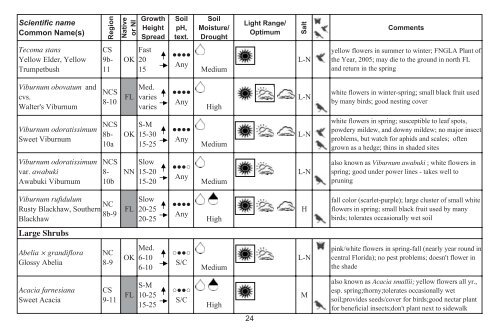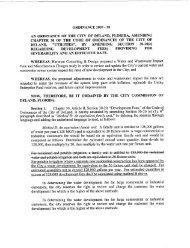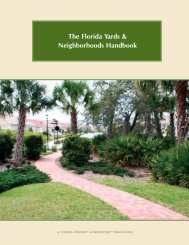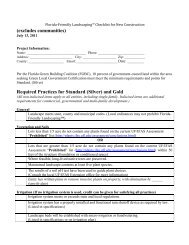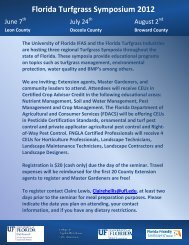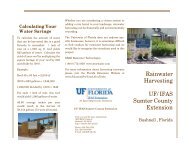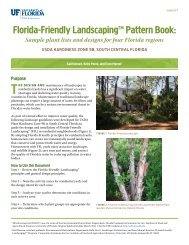A Guide to Florida-Friendly Landscaping A Guide to Florida-Fr ...
A Guide to Florida-Friendly Landscaping A Guide to Florida-Fr ...
A Guide to Florida-Friendly Landscaping A Guide to Florida-Fr ...
Create successful ePaper yourself
Turn your PDF publications into a flip-book with our unique Google optimized e-Paper software.
Scientific name<br />
Common Name(s)<br />
Region<br />
Native<br />
or NI<br />
Growth<br />
Height<br />
Spread<br />
Soil<br />
pH,<br />
text.<br />
Soil<br />
Moisture/<br />
Drought<br />
Light Range/<br />
Optimum<br />
Salt<br />
Comments<br />
Tecoma stans<br />
Yellow Elder, Yellow<br />
Trumpetbush<br />
CS<br />
9b-<br />
11<br />
OK<br />
Fast<br />
20<br />
15<br />
<br />
Any<br />
Medium<br />
L-N<br />
yellow flowers in summer <strong>to</strong> winter; FNGLA Plant of<br />
the Year, 2005; may die <strong>to</strong> the ground in north FL<br />
and return in the spring<br />
Viburnum obovatum and<br />
cvs.<br />
Walter's Viburnum<br />
NCS<br />
8-10<br />
FL<br />
Med.<br />
varies<br />
varies<br />
<br />
Any<br />
High<br />
L-N<br />
white flowers in winter-spring; small black fruit used<br />
by many birds; good nesting cover<br />
Viburnum odoratissimum<br />
Sweet Viburnum<br />
NCS<br />
8b-<br />
10a<br />
OK<br />
S-M<br />
15-30<br />
15-25<br />
<br />
Any<br />
Medium<br />
L-N<br />
white flowers in spring; susceptible <strong>to</strong> leaf spots,<br />
powdery mildew, and downy mildew; no major insect<br />
problems, but watch for aphids and scales; often<br />
grown as a hedge; thins in shaded sites<br />
Viburnum odoratissimum<br />
var. awabuki<br />
Awabuki Viburnum<br />
NCS<br />
8-<br />
10b<br />
NN<br />
Slow<br />
15-20<br />
15-20<br />
<br />
Any<br />
Medium<br />
L-N<br />
also known as Viburnum awabuki ; white flowers in<br />
spring; good under power lines - takes well <strong>to</strong><br />
pruning<br />
Viburnum rufidulum<br />
NC<br />
Rusty Blackhaw, Southern<br />
8b-9<br />
Blackhaw<br />
FL<br />
Slow<br />
20-25<br />
20-25<br />
<br />
Any<br />
High<br />
H<br />
fall color (scarlet-purple); large cluster of small white<br />
flowers in spring; small black fruit used by many<br />
birds; <strong>to</strong>lerates occasionally wet soil<br />
Large Shrubs<br />
Abelia × grandiflora<br />
Glossy Abelia<br />
NC<br />
8-9<br />
OK<br />
Med.<br />
6-10<br />
6-10<br />
<br />
S/C<br />
Medium<br />
L-N<br />
pink/white flowers in spring-fall (nearly year round in<br />
central <strong>Florida</strong>); no pest problems; doesn't flower in<br />
the shade<br />
Acacia farnesiana<br />
Sweet Acacia<br />
CS<br />
9-11<br />
FL<br />
S-M<br />
10-25<br />
15-25<br />
<br />
S/C<br />
High<br />
24<br />
M<br />
also known as Acacia smallii; yellow flowers all yr.,<br />
esp. spring;thorny;<strong>to</strong>lerates occasionally wet<br />
soil;provides seeds/cover for birds;good nectar plant<br />
for beneficial insects;don't plant next <strong>to</strong> sidewalk


